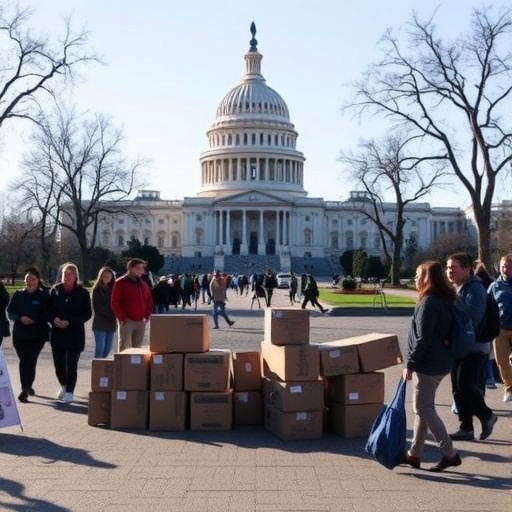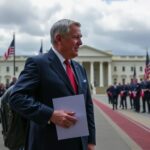U.S. Government shutdown Reaches Day 26: Federal Workers Flock to Food Banks Amid Partisan Budget Stalemate
As the U.S. federal Government shutdown stretches into its 26th day, the human cost is becoming starkly visible, with thousands of federal employees lining up at food banks and air travel grinding to a halt across the nation. This prolonged budget stalemate, fueled by partisan gridlock in Congress despite Republican control of both chambers and the White House, has left essential services teetering on the brink and everyday Americans caught in the crossfire.
- Federal Employees’ Desperate Turn to Food Banks Signals Deepening Crisis
- Air Travel Disruptions Worsen as TSA and FAA Face Unpaid Staff Shortages
- Partisan Gridlock in Congress Roots the Shutdown in Ideological Clashes
- Economic Fallout from the Shutdown Hits Businesses and Markets Hard
- Pathways to Resolution Emerge Amid Mounting Pressure for Compromise
The shutdown, which began on December 22, stems from deep divisions over a $1.4 trillion spending package that includes contentious provisions on border security funding and disaster relief. With no resolution in sight, federal workers—over 800,000 of whom are furloughed or working without pay—are facing unprecedented financial strain. Reports from major cities like Washington, D.C., and Atlanta indicate a surge in demand at local food pantries, where civil servants who once managed national parks or inspected food safety now queue for basic groceries.
“It’s heartbreaking to see dedicated public servants in this position,” said Sarah Jenkins, director of the Capital Area Food Bank in D.C., which has distributed 20% more meals this week alone. “These are the people who keep our country running, and now they’re turning to us because Congress can’t get its act together.”
Federal Employees’ Desperate Turn to Food Banks Signals Deepening Crisis
The plight of federal employees has emerged as the most poignant symbol of the Government shutdown‘s toll. In a nation where paychecks are the lifeline for millions, the absence of timely compensation has pushed many into survival mode. According to the Office of Personnel Management, approximately 380,000 civilian employees from agencies like the Department of Defense and the Environmental Protection Agency are furloughed, while another 420,000 are required to work without pay, including air traffic controllers and border agents.
Personal stories underscore the human drama. In Virginia, just outside Washington, Lisa Ramirez, a 15-year veteran at the National Institutes of Health, described skipping meals to cover rent. “I’ve got two kids and a mortgage,” Ramirez told reporters outside a local food bank. “I never thought I’d be here, but after 26 days, my savings are gone. This budget stalemate isn’t just politics—it’s destroying lives.” Her account is echoed nationwide: in California, USDA inspectors have reported dipping into retirement funds, while in New York, IRS workers are delaying medical treatments due to unpaid bills.
Statistics paint a grim picture. The Partnership for Public Service estimates that furloughed workers could lose up to $4,000 in wages by the end of the month, exacerbating food insecurity. Feeding America, a network of food banks, reported a 30% increase in visits from government workers in shutdown-affected areas. In Atlanta, the Atlanta Community Food Bank served over 5,000 federal families last week, a record high. “We’re seeing PhDs and engineers in line with single moms,” said executive director Bill Lucas. “The partisan gridlock in Congress has turned federal employees into the collateral damage of Washington’s dysfunction.”
Compounding the issue, many federal workers qualify for unemployment benefits, but processing delays due to the shutdown mean waits of up to six weeks. Economists warn that this ripple effect could slow consumer spending by $1.5 billion per week, hitting local economies hard. As the shutdown persists, community organizations are stepping up: churches in Maryland are hosting free dinners, and GoFundMe campaigns for affected workers have raised over $2 million.
Air Travel Disruptions Worsen as TSA and FAA Face Unpaid Staff Shortages
Beyond the food lines, the government shutdown is snarling one of America’s busiest travel seasons, with air travel disruptions mounting due to understaffed federal agencies. The Transportation Security Administration (TSA) and Federal Aviation Administration (FAA) are operating on skeleton crews, leading to widespread delays, canceled flights, and frustrated passengers at major airports from Los Angeles to Chicago.
Over the past week, the FAA has furloughed 13,000 employees, including safety inspectors and air traffic management specialists, resulting in reduced oversight and maintenance backlogs. At Los Angeles International Airport (LAX), wait times at security checkpoints have ballooned to over an hour, with TSA agents—many working without pay—calling out sick in protest. “We’re exhausted and unpaid,” said one anonymous TSA officer at Denver International Airport. “How can we keep planes safe when we’re barely making ends meet?”
Data from FlightAware shows a 15% increase in delays nationwide, with over 2,000 flights affected daily. During the holiday rush, this chaos peaked on Christmas Eve, when 1,200 flights were grounded or delayed due to staffing shortages. Airlines like Delta and United have issued waivers for rebookings, but travelers report hours-long lines and lost luggage piling up. In a particularly alarming incident, a near-miss at Reagan National Airport highlighted the risks, as understaffed controllers struggled to manage peak traffic.
The partisan gridlock exacerbating these issues traces back to disagreements in Congress over aviation funding within the broader spending bill. Republicans, holding majorities in both the House and Senate under President-elect’s influence, demand cuts to non-essential programs, while Democrats push for protections for federal employees and increased disaster aid. Transportation Secretary Elaine Chao has urged lawmakers to act, stating in a press release, “The safety of millions of Americans is at stake. This budget stalemate must end now.” Yet, with no votes scheduled, experts predict disruptions could persist into January, potentially costing the airline industry $500 million in lost revenue.
Passengers, many planning family reunions, are bearing the brunt. Social media is flooded with complaints: #ShutdownDelays has trended with stories of missed connections and stranded holiday travelers. Regional impacts are severe too—in Hawaii, FAA furloughs have delayed cargo flights, threatening fresh produce supplies to the islands.
Partisan Gridlock in Congress Roots the Shutdown in Ideological Clashes
At the heart of this 26-day government shutdown lies a stubborn partisan gridlock in Congress, where Republicans’ control of the legislative branch and alignment with the White House have paradoxically stalled progress on a routine budget. The dispute centers on a continuing resolution (CR) to fund the government through March, ballooned by add-ons like $5 billion for border wall construction and $14 billion for hurricane recovery in Florida and Puerto Rico.
House Speaker Paul Ryan and Senate Majority Leader Mitch McConnell have dug in, insisting on conservative spending caps to offset what they call “wasteful Democratic priorities.” Democrats, led by Minority Leader Nancy Pelosi, counter that the bill favors Republican pet projects while shortchanging social services. “This isn’t about budgets; it’s about power,” Pelosi said in a floor speech. “Federal employees and the public deserve better than this manufactured crisis.”
Negotiations have crumbled repeatedly: a bipartisan deal last week collapsed over immigration provisions, and a Senate vote on a clean CR failed 52-48 along party lines. Fiscal hawks within the GOP, including the Freedom Caucus, threaten to withhold support unless deeper cuts are made, prolonging the stalemate. White House Press Secretary Sarah Sanders defended the administration’s stance: “President Trump won’t sign a bill that doesn’t secure our borders. Congress must do its job.”
Historically, shutdowns under divided government have been shorter, but unified Republican control has amplified internal fractures. The 2013 shutdown lasted 16 days over the Affordable Care Act; today’s impasse, experts say, reflects heightened polarization post-2016 election. Political analysts like Norman Ornstein of the American Enterprise Institute note, “Partisan gridlock has evolved into trench warfare. Without compromise, this could drag on, costing taxpayers $1.2 billion daily.”
Public opinion is shifting: A new Quinnipiac poll shows 54% of Americans blame Republicans for the shutdown, with approval for Congress at a dismal 18%. Lobbyists from business groups like the U.S. Chamber of Commerce are pressuring lawmakers, warning of economic fallout.
Economic Fallout from the Shutdown Hits Businesses and Markets Hard
The ripple effects of the government shutdown extend far beyond federal employees, slamming businesses, stock markets, and local economies in ways that underscore the fragility of America’s fiscal machinery. As the budget stalemate endures, economists project a 0.1% drag on fourth-quarter GDP growth, with small businesses in D.C. reporting a 25% revenue drop due to closed monuments and federal offices.
Nationally, the shutdown has frozen $40 billion in economic activity, per the Congressional Budget Office. Contractors like defense firms Lockheed Martin and Boeing face payment delays on $20 billion in projects, leading to layoffs. In the housing market, FHA loan processing has halted, stalling 1,000 home sales weekly. Farmers awaiting USDA subsidies are defaulting on loans, while national parks—visited by 330 million annually—remain shuttered, costing gateway towns millions.
Wall Street has reacted nervously: The Dow Jones dipped 2% in the past week amid shutdown fears, with investor confidence at a two-year low. Goldman Sachs analysts forecast prolonged uncertainty could shave 0.5% off 2019 growth. “This partisan gridlock is a self-inflicted wound,” said Mark Zandi of Moody’s Analytics. “Federal employees’ hardships are just the tip; the real pain is in the stalled innovation and investment.”
Sector-specific hits are evident: In tech, NSF grant reviews are paused, delaying research; in energy, Interior Department permits for drilling are backlogged, frustrating oil companies in Texas. Non-profits reliant on federal grants, like those aiding veterans, report service cuts. A coalition of 200 CEOs has penned an open letter to Congress, urging resolution: “End this shutdown before it cripples our recovery.”
Internationally, the U.S. credit rating faces scrutiny—S&P Global warned of potential downgrades if the impasse continues, echoing the 2011 debt ceiling crisis.
Pathways to Resolution Emerge Amid Mounting Pressure for Compromise
As the government shutdown enters its 26th day, glimmers of hope for breaking the budget stalemate appear, driven by escalating pressure from voters, businesses, and even within Republican ranks. Bipartisan talks in the Senate are slated for this week, focusing on a stripped-down funding bill that could pass with minimal add-ons.
Key figures like Sen. Lindsey Graham (R-SC) have signaled flexibility, stating, “We can’t let partisan gridlock hurt our troops and families any longer.” Democrats are open to border funding tweaks if paired with employee backpay guarantees. The incoming Trump administration, set to take office in weeks, may wield influence to push a deal, though advisors hint at using the crisis to leverage wall funding.
Looking ahead, resolution could come via a short-term CR extending funding to February, buying time for comprehensive reforms. However, failure risks a longer shutdown, potentially overlapping with debt ceiling debates in March. Advocacy groups are mobilizing: The National Treasury Employees Union plans protests in D.C., while economists urge fiscal responsibility to avert recession.
For federal employees, backpay is assured once resolved, but the emotional scars linger. As one park ranger in Yellowstone put it, “We’ll recover financially, but trust in Congress? That’s shattered.” The nation watches, hoping Washington’s leaders prioritize governance over gridlock, restoring normalcy before the new year brings fresh challenges.








